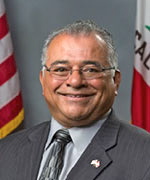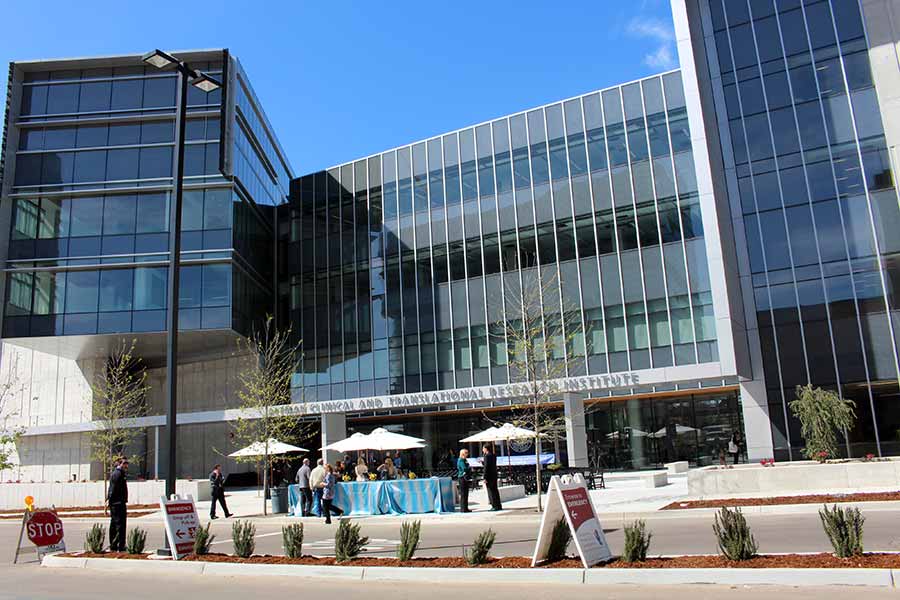Daily Business Report-March 22, 2016
The seven-story ACTRI building will house multiple institutes, centers and departments in 359,000 square feet of office and lab space.
Altman Clinical and Translational
Research Building Makes Debut
The Altman Clinical and Translational Research Institute Building — home to the Clinical and Translational Research Institute at UC San Diego — officially opened its doors on Friday.
The CTRI was established in 2010 as part of a national consortium of 60 medical research institutions created to energize bench-to-bedside efforts.
Funded with an initial five-year, $37.2 million grant from the National Center for Advancing Translational Science, part of the National Institutes of Health, the CTRI under Director and Associate Vice Chancellor of Translational Medicine Dr. Gary Firestein, last year garnered a $52 million grant renewal. The new award recognized the institute’s success in creating innovative programs that advance medical science and treatments.
The ACTRI building will provide infrastructure and support to basic, translational and clinical research throughout the region, conducted by more than 1,000 faculty and institutional partners. It serves as coordinating center for health sciences programs spanning two universities: the School of Medicine and Skaggs School of Pharmacy and Pharmaceutical Sciences at UC San Diego and the schools of Nursing and Public Health at San Diego State University, plus collaborations with Rady School of Management and Jacobs School of Engineering, both at UC San Diego.
__________________________________________________

Monarch Butterflies at Risk of Extinction
Findings of a Scripps-led study
City News Service
The largest segment of the North American monarch butterfly population could be headed toward quasi-extinction over the next couple of decades, according to a study released Monday by the Scripps Institution of Oceanography at UC San Diego and U.S. Geological Survey.
The study, published in the journal Scientific Reports, found that the number of the orange butterflies that migrate into the area of the U.S. and Canada east of the Rocky Mountains declined by 84 percent between the winter of 1996-97 and the winter of 2014-15. The butterflies spend their winters in central Mexico.
The researchers determined the chance of quasi-extinction — a point where the numbers become too few to recover a species — is 11 percent to 57 percent over the next 20 years. According to Scripps Oceanography, remaining members of a species might survive for a short time in such a worst-case circumstance, but the population as a whole will inevitably go extinct.
“Because monarch numbers vary dramatically from year to year depending on weather and other factors, increasing the average population size is the single most important way to provide these iconic butterflies with a much- needed buffer against extinction,” said Scripps biologist Brice Semmens, who studies extinction risk in fish and other animal populations.
The World Wildlife Fund Mexico and partners detected a large increase in monarch numbers since last year, but the butterflies might have subsequently been adversely affected by a winter storm. The scientists said a one-year population increase was good news, though higher averages over time are needed to reduce the risk of quasi-extinction.
Since counting butterflies individually is all but impossible, researchers observe the number of acres in Mexico covered by wintering monarch colonies.
According to the researchers, the butterflies filled just over 1 1/2 acres at their lowest point in the winter of 2013-14. The next winter, it was nearly 2.8 acres, and the winter that just ended saw a huge increase to 10 acres.
Officials and scientists in the U.S., Mexico and Canada hope to bump up the population to cover 15 acres by 2020.
The eastern population studied by the researchers is one of two, and the most abundant. The western monarchs stay west of the Rocky Mountains, according to Scripps.
Sequenom Petitions High Court
On Patent Covering DNA Detection
San Diego life sciences company Sequenom has petitioned the U.S. Supreme Court to review lower court decisions invalidating its patent on DNA detection in the blood of pregnant women.
In October 2013, a U.S. District Court ruled that the patent, covering the detection of cell-free DNA in the blood of pregnant women, was invalid because a phenomenon of nature is unpatentable. The ruling was upheld on appeal.
“We continue to believe that the groundbreaking techniques embodied in the 540 patent are eligible for patent protection,” said Dirk van den Boom, CEO of Sequenom. “More broadly, we believe our case provides a compelling opportunity for the Supreme Court to clarify patent eligibility criteria to protect the significant investments made by Sequenom and other life sciences organizations that have undoubtedly advanced the standard of patient care and treatment, as well as encouraging future such investments.”
The company said the lower court decision will not have a material impact on its ongoing business since it has been operating under the District Court’s invalidity ruling since October 2013 and it has a pooling arrangement of noninvasive prenatal testing intellectual property with Illumina.

MTS Buying Trolleys, Buses
In $108 Million Capital Program
Times of San Diego
The Metropolican Transit System’s board has approved a $108 million capital spending program for 2017 that includes new buses and trolleys.
The majorprojects in the budget include:
• Eight new low-floor Trolleys — $31 million
• 45 Compressed Natural Gas buses — $23 million
• New transit facility (location to be determined) — $7.1 million
• New Courthouse Trolley Station on C Street between State and Union streets — $5.7 million
• 46 near-zero emission paratransit buses — $4.7 million
CEO Paul Jablonski said that having a capital budget of over $100 million “very healthy” for a transit agency of San Diego’s size. “This includes new trolleys and buses, transit facility upgrades, hundreds of bus benches and bus shelters, technology improvements and more,” he said. “MTS is committed to providing the best rider experience possible.”
MTS operates 95 bus routes and three trolley lines on 53 miles of double-tracked railway. Every weekday more than 300,000 trips are taken on the MTS.
The transit system set a new record in 2015 with 96.7 million riders.

Sycuan Casino Donates $50,000
To Challenged Athletes Foundation
Bill Walton accepted a $50,000 check from Sycuan Casino on behalf of the Challenged Athletes Foundation — part of the casino’s promise to donate at least 5 percent of its GameDay Sports Bar & Grill’s annual sales.
“CAF, being San Diego based, has been really able to capitalize on the opportunity Sycuan has afforded us to provide life-changing grants for equipment, sports training expenses and other things to really allow people with physical challenges to be active, be physically involved in sports,” said Jason Karavidas, business development manager for Challenged Athletes Foundation.
The casino held an event open to the public on Sunday to commemorate the occasion. At the event, Walton met and greeted casino patrons alongside several athletes connected with the Challenged Athletes Foundation.
“It’s one of those foundations that we’re very proud of, and we’re very proud of the work that we’ve been able to do in the community. It really reinforces to the ‘together’ piece of our new strategy. We’re going to continue this for many years to come,” said John Dinius, Sycuan Casino’s newly appointed general manager.
Hanlon, Chavez Reappointed
To Governor’s Military Council


Edward Hanlon Jr. , 71, of Carlsbad, and Assemblyman Rocky J. Chavez, 64, of Oceanside, have been reappointed to the Governor’s Military Council by Gov. Jerry Brown. Hanlon was appointed vice chair of the council.
Hanlon has been on the council since 2013. He has been president at Transatlantic Insights LLC since 2012. He was vice president at Raytheon and president at Raytheon International Europe from 2007 to 2012 and served as U.S. military representative to the North Atlantic Treaty Organization Military Committee from 2004 to 2006. Hanlon served as commanding general of the U.S. Marine Corps Combat Development Command from 2001 to 2004 and of the U.S. Marine Corps Base Camp Pendleton from 1998 to 2001.
He was director of expeditionary warfare in the U.S. Navy from 1996 to 1998. Hanlon earned a Master of Arts degree in communication theory from the University of Minnesota and a Master of Arts degree in human resources management from Pepperdine University. The position does not require Senate confirmation and there is no compensation. Hanlon is a Republican.
Chavez has been on the council since 2013. He has served as a member of the Assembly since 2012. He served as undersecretary at the California Department of Veterans Affairs from 2009 to 2010 and as a member of the Oceanside City Council from 2002 to 2009. Chavez was a marine officer in the U.S. Marine Corps from 1974 to 2002.
The positions do not require Senate confirmation and there is no compensation. Both men are Republican.

Study Shows Level of Panda Hearing
Sensitivity beyond human range
may have conservation implications
A study published in the journal Global Ecology and Conservation may help field conservationists better understand the potential for human activities to disturb endangered giant pandas in native habitats. Using pandas located at the San Diego Zoo, conservation scientists worked with animal care specialists to determine pandas’ range of hearing sensitivity, discovering that they can detect sound into the ultrasonic range. Because giant pandas depend in large part on information transmitted through vocalizations for reproductive success, noise from human activities in or near forest areas could be disruptive.
“An understanding of a species’ hearing provides a foundation for developing estimates of noise disturbance,” said Megan Owen, associate director of giant panda conservation, San Diego Zoo Global. “For the giant panda, vocalizations are typically emitted in proximity to conspecifics (members of the same species), however the ability to discriminate between fine-scale differences in vocalizations is important for successful reproduction; and so, a thorough understanding of acoustic ecology is merited in order to estimate the potential for disturbance.
“In order to learn about panda hearing, researchers at the San Diego Zoo worked with giant pandas to teach them to respond, if they could hear sounds at a particular pitch and loudness, thus communicating their ability to hear across the acoustic spectrum,” Owen said.
“Through this study, the pandas at the San Diego Zoo have made a significant contribution to our understanding of what may be affecting panda reproduction in habitats in China,” said Ron Swaisgood, director of applied animal ecology, San Diego Zoo Global. “It is only because of the strong relationship that animal care staff have with the bears at the Zoo that we have been able to gather this information.”
Personnel Announcements
Lisa Churchill Joins Cushman & Wakefield

Lisa Churchill has joined Cushman & Wakefield as the asset services city lead for the San Diego market.
Churchill will be responsible for growing Cushman & Wakefield’s ssset services business in San Diego, currently consisting of more than 9 million square feet of office, industrial and retail space. She also will focus on recruiting top industry professionals.
Churchill has 15 years of commercial real estate experience. She was previously senior real estate manager at CBRE and led the firm’s 3 million-square-foot management portfolio in Phoenix. Churchill also worked in the San Diego market from 2001 to 2003 and again in 2013 and 2014 overseeing a diverse portfolio of office, retail and industrial assets located across San Diego County and the Inland Empire.




